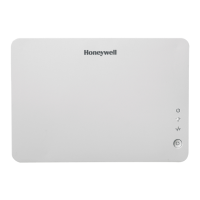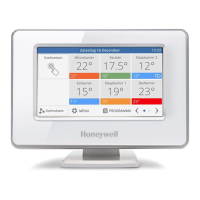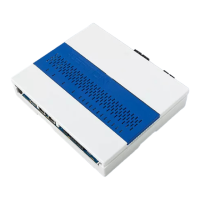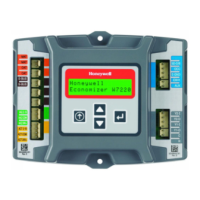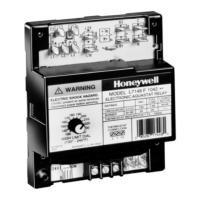ENGINEERING MANUAL OF AUTOMATIC CONTROL
CONTROL FUNDAMENTALS
20
Fig. 27. Staged Reciprocating Chiller Control.
Figure 28 shows step control of sequenced DX coils and
electric heat. On a rise in temperature through the throttling
range at the thermostat, the heating stages sequence off. On a
further rise after a deadband, the cooling stages turn on in
sequence.
ACTUATOR
AIRFLOW
DAMPER
REFERENCE
PRESSURE
PICK-UP
STATIC
PRESSURE
PICK-UP
FLOATING
STATIC
PRESSURE
CONTROLLER
C2717
zero, and the sequence repeats until all stages required to meet
the load condition are on. On a decrease in load, the process
reverses.
With microprocessor controls, step control is usually done
with multiple, digital, on-off outputs since software allows
easily adjustable on-to-off per stage and interstage differentials
as well as no-load and time delayed startup and minimum on
and off adjustments.
FLOATING CONTROL
Floating control is a variation of two-position control and is
often called “three-position control”. Floating control is not a
common control mode, but is available in most microprocessor-
based control systems.
Floating control requires a slow-moving actuator and a fast-
responding sensor selected according to the rate of response
in the controlled system. If the actuator should move too slowly,
the controlled system would not be able to keep pace with
sudden changes; if the actuator should move too quickly, two-
position control would result.
Floating control keeps the control point near the setpoint at
any load level, and can only be used on systems with minimal
lag between the controlled medium and the control sensor.
Floating control is used primarily for discharge control systems
where the sensor is immediately downstream from the coil,
damper, or device that it controls. An example of floating
control is the regulation of static pressure in a duct (Fig. 29).
ON
OFF
ONOFF
ONOFF
ONOFF
4
3
2
1
DIFFERENTIAL
THROTTLING RANGE
76
SPACE TEMPERATURE (°F)
72
100%
0%
LOAD
C2093
STAGES
74
SETPOINT
SPACE OR
RETURN AIR
THERMOSTAT
ACTUATOR
SOLENOID
VALVES
FAN
DISCHARGE
AIR
DIRECT EXPANSION
COILS
MULTISTAGE
ELECTRIC HEAT
STEP
CONTROLLER
STAGE NUMBERS
6
5
4
3
2
1
C2716
D
X
D
X
Fig. 28. Step Control with Sequenced DX Coils and
Electric Heat.
A variation of step control used to control electric heat is
step-plus-proportional control, which provides a smooth
transition between stages. This control mode requires one of
the stages to be a proportional modulating output and the others,
two-position. For most efficient operation, the proportional
modulating stage should have at least the same capacity as
one two-position stage.
Starting from no load, as the load on the equipment increases,
the modulating stage proportions its load until it reaches full
output. Then, the first two-position stage comes full on and
the modulating stage drops to zero output and begins to
proportion its output again to match the increasing load. When
the modulating stage again reaches full output, the second two-
position stage comes full on, the modulating stage returns to
Fig. 29. Floating Static Pressure Control.
In a typical application, the control point moves in and out
of the deadband, crossing the switch differential (Fig. 30). A
drop in static pressure below the controller setpoint causes the
actuator to drive the damper toward open. The narrow
differential of the controller stops the actuator after it has moved
a short distance. The damper remains in this position until the
static pressure further decreases, causing the actuator to drive
the damper further open. On a rise in static pressure above the
setpoint, the reverse occurs. Thus, the control point can float
between open and closed limits and the actuator does not move.
When the control point moves out of the deadband, the
controller moves the actuator toward open or closed until the
control point moves into the deadband again.

